“Better than a thousand days of diligent study is one day with a great teacher.”
— Japanese proverb
Feel free to download and share this quote or image.
“Better than a thousand days of diligent study is one day with a great teacher.”
— Japanese proverb
Feel free to download and share this quote or image.
I was honored to recently make a guest appearance on Tim Topham‘s podcast for piano teachers, to speak on the topic of Harnessing The Power of the Internet. You can take a listen here or watch the YouTube video version below.
Tim asked me to talk about a topic I had presented earlier this year at the 2015 MTNA conference in Las Vegas during the Young Professionals Track, called: Harnessing the Power of the Internet. We discussed ideas and strategies for using the internet well, forming an online presence, and using social media.
 By the way, I also decided to share a readable version of my MTNA presentation. If you would like to take a look, you can download the PDF below or on the Printables > Other Resources page.
By the way, I also decided to share a readable version of my MTNA presentation. If you would like to take a look, you can download the PDF below or on the Printables > Other Resources page.
 PDF Presentation: Harnessing the Power of the Internet (2.2 MiB, 3,062 hits)
PDF Presentation: Harnessing the Power of the Internet (2.2 MiB, 3,062 hits)
Be sure to check out the rest of Tim’s blog here. There are many great resources to be found there!
My piano student, Bella, loved coloring this beautiful mandala coloring sheet created by my piano teacher friend Susan Hong. This kept her busy during her brothers’ lessons. 🙂 Thanks for the printable, Susan!

You can download Susan’s beautiful printable for FREE here at TeachersPayTeachers.com.
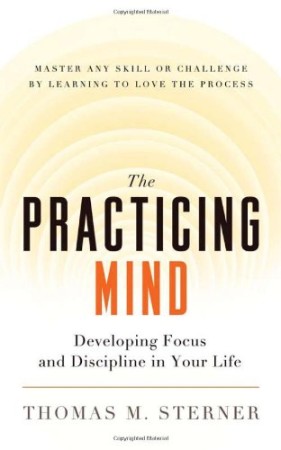 “The Practicing Mind: Master Any Skill or Challenge by Learning To Love the Process” is a bestselling book by Thomas M. Sterner that is applicable to non-musicians and musicians alike. The author happens to be a piano technician by trade and in the past held a high-pressure job preparing pianos at a performance venue for visiting concert pianists. The book provides helpful tips and strategies for anyone who is practicing in order to learn a skill, whether it be music, golfing, speaking a foreign language, or any pursuit.
“The Practicing Mind: Master Any Skill or Challenge by Learning To Love the Process” is a bestselling book by Thomas M. Sterner that is applicable to non-musicians and musicians alike. The author happens to be a piano technician by trade and in the past held a high-pressure job preparing pianos at a performance venue for visiting concert pianists. The book provides helpful tips and strategies for anyone who is practicing in order to learn a skill, whether it be music, golfing, speaking a foreign language, or any pursuit.
I gained some very helpful tips and mindsets from the book. Here are two examples:
The book is under 150 pages and is fun and easy reading — yet thought provoking. I highly recommend this book to anyone who practices, whether it is music or other pursuits. I have recommended it to a couple of my adult students who likewise found it helpful and enjoyable.
Find the book on Amazon here.
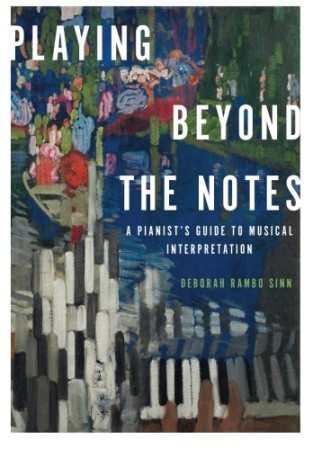 Deborah Rambo Sinn’s Playing Beyond the Notes: A Pianist’s Guide to Musical Interpretation is a helpful and delightful reference for pianists and piano teachers alike. The book is organized into twelve chapters with titles such as “Boxes and Beams,” “Ornamentation,” “Deconstructing Phrases,” and “Pedaling.” The book systematically addresses common issues and helpful guidelines for performance practice in piano literature.
Deborah Rambo Sinn’s Playing Beyond the Notes: A Pianist’s Guide to Musical Interpretation is a helpful and delightful reference for pianists and piano teachers alike. The book is organized into twelve chapters with titles such as “Boxes and Beams,” “Ornamentation,” “Deconstructing Phrases,” and “Pedaling.” The book systematically addresses common issues and helpful guidelines for performance practice in piano literature.
For every concept or principle addressed in the book, the author presents at least one example passage from a piece from the canon of standard classical piano repertoire. Readers can either play the passage themselves on the piano to experiment with the concept being addressed, or visit the companion website to listen to the provided sound recordings there. The referenced pieces include sonata movements by Beethoven, Haydn, and Mozart; Romantic works by Chopin, Schumann, Brahms, and Mendelssohn; and Bach Prelude and Fugues; and more.
Playing Beyond the Notes provides the reader insight into the way that artists can and should examine the score to find clues for forming an effective and convincing interpretation. If you have ever wished for more clarification on the various types of staccato or other articulation markings, or wanted more insight into how to understand a piece of music from its most detailed markings, sub-phrases, and phrases, all the way out to the larger-structure sections of the piece, you will find this book to be a helpful guide. My favorite chapter was the final chapter, on pedaling. In that chapter, the author provides some very helpful guidelines to follow when using pedal, supported by excellent examples.
This book is a helpful resource for piano teachers seeking to gain more strategies for guiding their advancing students play more musically. It is also a good book to recommend to advanced-level high school and adult students to read for themselves. The book is also the perfect textbook for college-level courses, such as those that address piano literature or the topic of performance practice. At the end of each chapter, there is a list of questions that could be used as discussion questions or assignments.
This book is ought to be a staple on every pianist’s bookshelf and is bound to become a timeless reference on performance practice of the 21st century.
Find it here on Amazon.
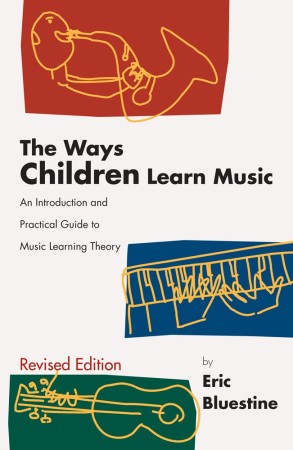 The Ways Children Learn Music is a book for music teachers written by Eric Bluestine. As the subtitle indicates, the book is intended to serve as “An introduction and practical guide to Music Learning Theory.” Music Learning Theory, or MLT, is a set of theories about music learning developed by Dr. Edwin Gordon and others (click here to read a summary of Dr. Gordon’s written speech at NCKP 2015) . MLT is a fascinating set of ideas that strives to teach music based on how the brain most organically learns music.
The Ways Children Learn Music is a book for music teachers written by Eric Bluestine. As the subtitle indicates, the book is intended to serve as “An introduction and practical guide to Music Learning Theory.” Music Learning Theory, or MLT, is a set of theories about music learning developed by Dr. Edwin Gordon and others (click here to read a summary of Dr. Gordon’s written speech at NCKP 2015) . MLT is a fascinating set of ideas that strives to teach music based on how the brain most organically learns music.
Edwin Gordon has authored numerous books about music education and music learning; however, his writings are admittedly not for the faint of heart. It’s pretty heavy reading, and perhaps not recommended for someone new to MLT. Eric Bluestine’s book is intended to serve as a friendly introduction to MLT for the person with a casual or new interest in MLT. It is a thought-provoking book that will benefit music teachers of all instruments.
MLT itself is not a curriculum. It is a set of theories, as stated above. MLT tries to understand how we gain musical skills and learn content most effectively. From MLT, educators can form their own learning methods and a personal curriculum and teaching style. In his book, Bluestine makes an effort to show by his own example how he has begun to form his own “curriculum” of sorts, as every educator must, based on MLT.
When I was an undergraduate music major at Hope College, Edwin Gordon visited to give a day-long workshop and a series of guest visits into our music classes. He made a huge impact on me and my fellow music majors. One particular thing I gained at the time from Edwin Gordon’s ideas is the term he coined: “audiation.” We have known about audiation for centuries, but until Gordon, no one gave it a name. Audiation refers to the phenomenon of “hearing” music (either physically or in your mind) with understanding. Musicians audiate all the time. For example, we use audiation when we play a familiar tune by ear on the piano. I think that much of music education is actually about developing and increasing our ability to audiate.
Back to Bluestine’s book. The Ways Children Learn Music will make you reconsider some of the choices music educators traditionally make. For example, Bluestine discusses the fact that there are many concepts that music education traditionally teaches backwards: for example, teaching scales and intervals before students really understand what tonality is, or teaching what quarter notes and half notes are before students really understand the natural hierarchy of macrobeats and microbeats in music.
This is the kind of book that asks many questions and provokes deep thought, but does not necessarily provide all of the answers. This book will challenge you, cause you to re-think what you understand about music education, and help you grow as a music educator!
I highly recommend this book for any music teacher’s bookshelf. Find it here on Amazon.
To learn more about Dr. Gordon and MLT, visit giml.org. To learn about the only piano method to date that has been written based on the ideas of MLT, visit Marilyn Lowe’s website: musicmovesforpiano.com. (Note: Familiarity with MLT is recommended before using her method.)
_ _ _ _ _
To read next: What is Audiation, Exactly?
“I cannot teach anybody anything. I can only make them think.”
— Socrates
Feel free to download and share this quote or image.
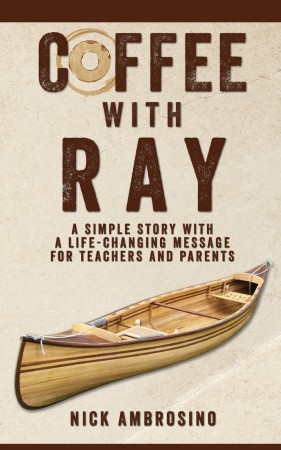 I have another review for you today! Over the last six months or so, I’ve made an conscious effort to try to read more books. I regularly read a lot of blogs and online forums, but had somehow gotten away from books. In upcoming weeks, I hope to share reviews about all of the books I’ve read recently.
I have another review for you today! Over the last six months or so, I’ve made an conscious effort to try to read more books. I regularly read a lot of blogs and online forums, but had somehow gotten away from books. In upcoming weeks, I hope to share reviews about all of the books I’ve read recently.
Coffee with Ray is a short, inspirational yet instructive book by Nick Ambrosino written for piano teachers — or any teachers, for that matter.
The book is similar to an instructional dialogue: meaning, a work of nonfiction written as a dialogue, such as Plato’s Apology or Fux’s The Art of Counterpoint. The difference is that this book is written in first person, making it read even more like fiction. Coffee With Ray recounts the story of a piano teacher, Matt, who has lost his sense of purpose as a teacher and is dealing struggling with burnout. Matt has a chance encounter with a mysterious character, Ray, who imparts pedagogical wisdom and principles to Matt that help him regain a sense of fulfillment in teaching again.
Readers will relate to Matt’s frustrations with the profession of piano teaching and, along with Matt, learn or be reminded of certain teaching strategies and helpful perspectives for teachers.
I highly recommend this book, assuming you are comfortable overlooking a few instances of colorful language. The book is divided into eight chapters and is just over one hundred pages in length. You will probably find yourself reading the whole book in just one or two sittings — it is easy reading and you won’t want to put it down. The pedagogical principles are practical and applicable. It is light, entertaining reading with a big impact. Order a copy for yourself and a second for a friend!
Find it on Amazon here. And just so you know, a sequel has been released, too (I haven’t read it yet!) called Lessons With Matt.
 I’m pleased to review a collection of teacher-student piano duets today called Fairyland in Treble by London-based Greek composer Nikolas Sideris.
I’m pleased to review a collection of teacher-student piano duets today called Fairyland in Treble by London-based Greek composer Nikolas Sideris.
I must first say, the book is gorgeous. The paper is heavy and a lovely creamy color. The cover design, as you can see from the photo here, is beautiful. The typography, layout, and notation is likewise top quality and pleasing to the eye throughout the book.
The book is a whopping 72 pages in length. There are eleven different pieces in the book, all written at a mid- to late-intermediate level and centered around a theme of fairy tales. As the Preface states, the duets are based on music the composer composed over the past eight years primarily for use in computer game soundtracks. Over the years, Nikolas adapted the music into teacher/student duets. To give you some idea, the titles include: A Playful Countess, The Bold Barber, The Duke and the Cook, Fifi on the Moon, and The Pirate Highsea Games.
Before each piece in the book, there is a written-out fairy tale story authored by Nefeli Tsipouridi. In addition, each piece is accompanied by a QR code which can be scanned using any QR code reader app to quickly pull up a recording of the secondo part (teacher’s part) for the student to practice along with.
The duets are of good length, making them a nice option for recitals or other performances.
On to the music! Here is a lovely video of the composer performing the duets with another pianist/teacher, Miriam Kornberg. The pieces are beautiful, expressive, and enjoyable to hear and play. I love the variety of modes and moods used throughout the book.
One of my intermediate students and I learned the first duet from the book, The King and the Dragon, and we really have enjoyed the piece! I would highly recommend this book for you and your intermediate students. Another possible use: I like to use duets for sight-reading. If you have have advanced students, they might enjoy this book for that purpose during lesson time.
Order your copy of the book here.
Disclosure: I received a complimentary copy of this book for review. However, as always, I write honest reviews.
During my two-week break from teaching last month, I finished a project I’ve been wanting to do for awhile now. I initially saw the idea on Pinterest and was thrilled to finally find the materials I needed!
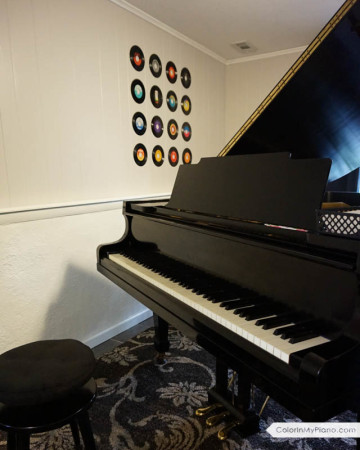
It’s wall art created using old 45 records! At a thrift store back home in Michigan, I found 45’s for sale priced at 6 for $1. I selected the ones with the most colorful labels.

You could also use standard-sized vinyl records for this project, but you would need a much larger wall space.
I hung the records using small Command hooks. Have you used them before for your walls? They are wonderful! No need to pound holes into your walls. I bought a package of the smallest sized clips, which are only appropriate for hanging light-weight things. They were perfect for this project.

The clips allow the records to easily slip into place, and I can even rearrange the order of the records if I want to. Using pencil and a tape measure, I marked out the places where I wanted to the hooks to go. I measured and re-measured and RE-measured to make sure that the clips were evenly spaced. 🙂
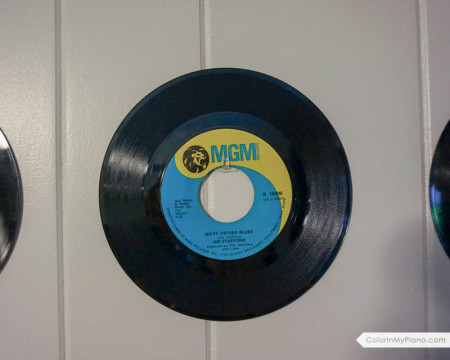
I love how it turned out! It adds color to my wall that I can enjoy every day from my teaching chair.
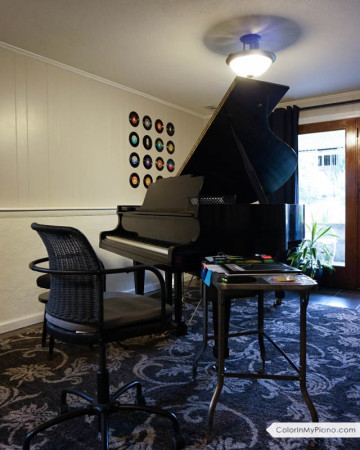
It was an inexpensive, fun project — and perfect for a music-themed room!
“What we learn with pleasure we never forget.”
— Alfred Mercier
Feel free to download and share this quote or image.
Your Cart is Empty